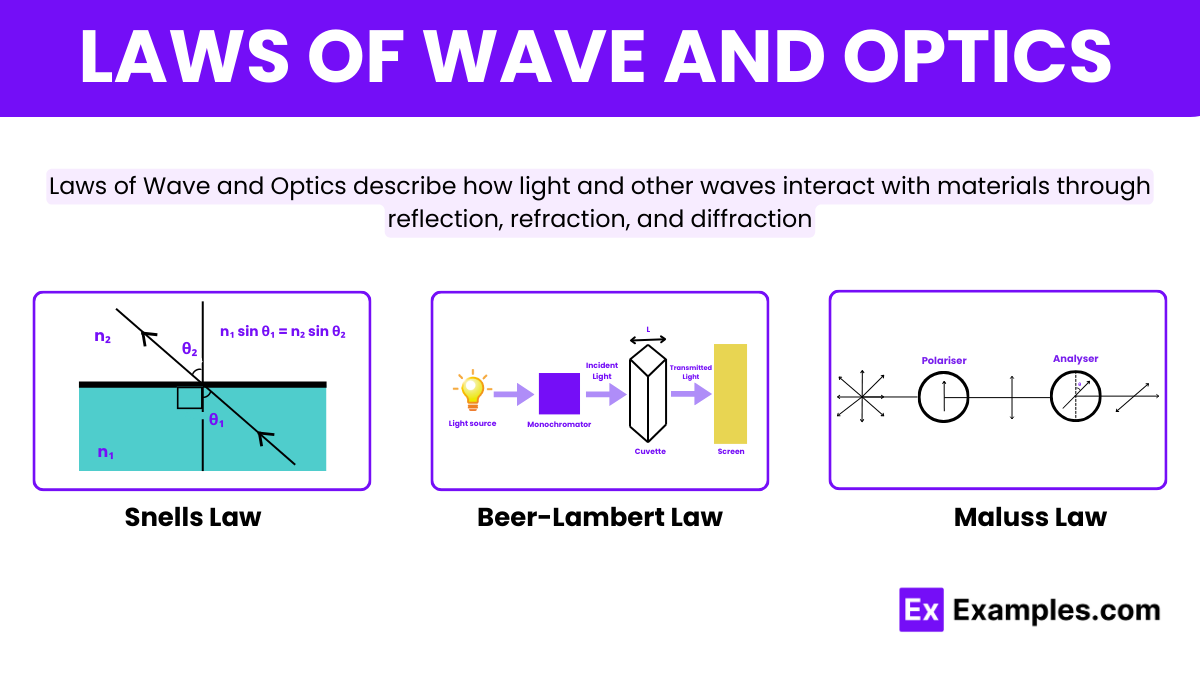What is the principle of superposition in wave theory?
Waves can only travel in a vacuum
The resultant displacement is the sum of individual displacements
Light cannot be diffracted
Waves travel at constant speed in all mediums

The fascinating world of waves and optics is governed by several fundamental principles, known as the laws of wave and optics. These laws help us understand how light and sound travel through different mediums, behave under various conditions, and interact with matter. At its core, wave behavior can be explained through the law of physics that involves concepts like wavelength, frequency, and speed. Optics, a branch of physics, primarily focuses on the study of light, including its reflection, refraction, and dispersion through lenses and mirrors. Grasping these principles allows us to explore everything from the basic mechanics of seeing to the complexities of modern optical technologies.
Ancient scholars such as Euclid and Ptolemy outlined the laws of reflection, observing how light reflects at equal angles. In the 11th century, Alhazen transformed optics with extensive experiments on refraction and reflection documented in his Book of Optics.
The 17th century saw significant advancements with Isaac Newton proposing that light consists of particles, which influenced our understanding of light propagation and color. Conversely, Christiaan Huygens developed the wave theory of light, explaining phenomena like interference and diffraction more effectively.
In the 19th century, Augustin-Jean Fresnel bolstered the wave theory with mathematical equations. Thomas Young demonstrated wave interference in his double-slit experiment. This period solidified the understanding of light as a wave, setting the foundation for modern optical physics, which continues to progress with new technologies and discoveries in wave behavior and light interactions.
Snell’s Law describes the relationship between the angles of incidence and refraction when light passes from one transparent medium to another. Snell’s Law states that the ratio of the sine of the angles of incidence and refraction is constant. It dependent on the refractive indices of the two media.
Young’s Double Slit Experiment demonstrates the wave nature of light. When light passes through two closely spaced slits. It produces an interference pattern on a screen, showing alternating bright and dark bands. This experiment confirms that light waves can interfere with each other, creating patterns of constructive and destructive interference.
Beer-Lambert Law relates the absorption of light to the properties of the material through which the light is traveling. It states that the absorbance of light by a medium is directly proportional to the concentration of the absorbing substance and the path length through which the light travels.
Malus’s Law describes the intensity of polarized light transmitted through a polarizer. It states that the transmitted light intensity is proportional to the square of the cosine of the angle between the light’s initial polarization direction and the axis of the polarizer.
Bragg’s Law is used to explain the angles at which light or x-rays are diffracted by crystalline structures. It states that diffraction occurs when the wavelength of the waves is comparable to the spacing between the layers in the crystal. It satisfying the equation
Fermat’s Principle of Least Time asserts that light takes the quickest path between two points. This principle is crucial in deriving the laws of reflection and refraction. It helps explain why light bends towards the normal when entering a denser medium and away when entering a less dense medium.
The first law of optics is the Law of Reflection: the angle of incidence equals the angle of reflection.
Snell’s Law defines how light bends changing media, based on refractive indices.
The three types are geometric optics, wave optics, and quantum optics.
Text prompt
Add Tone
10 Examples of Public speaking
20 Examples of Gas lighting
What is the principle of superposition in wave theory?
Waves can only travel in a vacuum
The resultant displacement is the sum of individual displacements
Light cannot be diffracted
Waves travel at constant speed in all mediums
What does Snell's Law describe in optics?
Reflection of light
Refraction of light
Diffraction of light
Polarization of light
According to Snell's Law, which formula represents the relationship between the angle of incidence (θ₁) and the angle of refraction (θ₂)?
n₁sinθ₁ = n₂sinθ₂
n₁cosθ₁ = n₂cosθ₂
n₁tanθ₁ = n₂tanθ₂
n₁θ₁ = n₂θ₂
What is Huygens' Principle in wave theory?
Light consists of particles
Each point on a wavefront acts as a source of secondary wavelets
Light cannot be polarized
Only transverse waves can propagate
What is the phenomenon where light bends around obstacles and openings?
Reflection
Refraction
Diffraction
Dispersion
Which law states that the angle of incidence is equal to the angle of reflection?
Snell's Law
Law of Reflection
Huygens' Principle
Fermat's Principle
What does the Doppler Effect describe in wave motion?
Change in wave speed due to medium
Change in frequency due to relative motion
Interference patterns of waves
Reflection of waves
What is the term for the splitting of white light into its component colors?
Polarization
Diffraction
Dispersion
Interference
What does Fermat's Principle state about the path taken by light?
Light always travels in a straight line
Light takes the path that requires the least time
Light cannot change direction
Light speed is constant in all media
In Young's double-slit experiment, what causes the bright and dark fringes on the screen?
Reflection
Refraction
Diffraction
Interference
Before you leave, take our quick quiz to enhance your learning!

